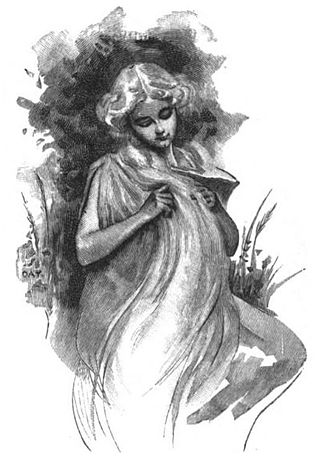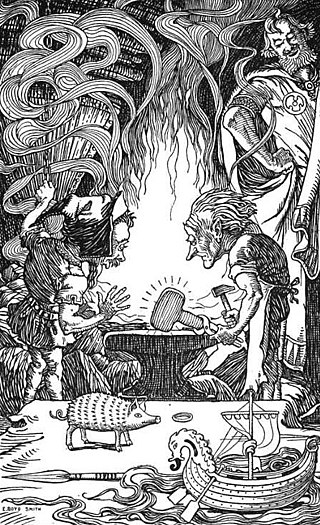
In Norse mythology, Freyja is a goddess associated with love, beauty, fertility, sex, war, gold, and seiðr. Freyja is the owner of the necklace Brísingamen, rides a chariot pulled by two cats, is accompanied by the boar Hildisvíni, and possesses a cloak of falcon feathers. By her husband Óðr, she is the mother of two daughters, Hnoss and Gersemi. Along with her twin brother Freyr, her father Njörðr, and her mother, she is a member of the Vanir. Stemming from Old Norse Freyja, modern forms of the name include Freya, Freyia, and Freja.

A dwarf is a type of supernatural being in Germanic folklore. Accounts of dwarfs vary significantly throughout history; however, they are commonly, but not exclusively, presented as living in mountains or stones and being skilled craftsmen. In early literary sources, only males are explicitly referred to as dwarfs. However, they are described as having sisters and daughters, while male and female dwarfs feature in later saga literature and folklore. Dwarfs are sometimes described as short; however, scholars have noted that this is neither explicit nor relevant to their roles in the earliest sources.

In Norse mythology, Sif is a golden-haired goddess associated with earth. Sif is attested in the Poetic Edda, compiled in the 13th century from earlier traditional sources, and the Prose Edda, written in the 13th century by Snorri Sturluson, and in the poetry of skalds. In both the Poetic Edda and the Prose Edda, she is known for her golden hair and is married to the thunder god Thor.

In Norse mythology, Brokkr is a dwarf, and the brother of Eitri or Sindri.

Þrúðr, sometimes anglicized as Thrúd or Thrud, is a daughter of the major god Thor and the goddess Sif in Norse mythology. Þrúðr is also the name of one of the valkyries who serve ale to the einherjar in Valhalla. The two may or may not be the same figure.

In Norse mythology, Nótt is personification of the night. In both the Poetic Edda, compiled in the 13th century from earlier traditional sources, and the Prose Edda, composed in the 13th century, Nótt is listed as the daughter of a figure by the name of Nörvi and is associated with the horse Hrímfaxi, while the Prose Edda features information about Nótt's ancestry, including her three marriages. Nótt's third marriage was to the god Dellingr and this resulted in their son Dagr, the personified day. As a proper noun, the word nótt appears throughout Old Norse literature.
In Norse mythology, Móði and Magni are the sons of Thor. Their names translate to "Wrath" and "Mighty," respectively. Rudolf Simek states that, along with Thor's daughter Þrúðr ("Strength"), they embody their father's foot.

Mjölnir is the hammer of the thunder god Thor in Norse mythology, used both as a devastating weapon and as a divine instrument to provide blessings. The hammer is attested in numerous sources, including the 11th century runic Kvinneby amulet, the Poetic Edda, a collection of eddic poetry compiled in the 13th century, and the Prose Edda, a collection of prose and poetry compiled in the 13th century. The hammer was commonly worn as a pendant during the Viking Age in the Scandinavian cultural sphere, and Thor and his hammer occur depicted on a variety of objects from the archaeological record. Today the symbol appears in a wide variety of media and is again worn as a pendant by various groups, including adherents of modern Heathenry.

Thor is a prominent god in Germanic paganism. In Norse mythology, he is a hammer-wielding god associated with lightning, thunder, storms, sacred groves and trees, strength, the protection of humankind, hallowing, and fertility. Besides Old Norse Þórr, the deity occurs in Old English as Thunor, in Old Frisian as Thuner, in Old Saxon as Thunar, and in Old High German as Donar, all ultimately stemming from the Proto-Germanic theonym *Þun(a)raz, meaning 'Thunder'.

Máni is the Moon personified in Germanic mythology. Máni, personified, is attested in the Poetic Edda, compiled in the 13th century from earlier traditional sources, and the Prose Edda, written in the 13th century by Snorri Sturluson. Both sources state that he is the brother of the personified sun, Sól, and the son of Mundilfari, while the Prose Edda adds that he is followed by the children Hjúki and Bil through the heavens. As a proper noun, Máni appears throughout Old Norse literature. Scholars have proposed theories about Máni's potential connection to the Northern European notion of the Man in the Moon, and a potentially otherwise unattested story regarding Máni through skaldic kennings.

Alvíssmál is a poem collected in the Poetic Edda, probably dating to the 12th century, that describes how the god Thor outwits a dwarf called Alvíss ("All-Wise") who seeks to marry his daughter.

In Norse mythology, the Sons of Ivaldi are a group of dwarfs who fashion Skíðblaðnir, the flying ship of Freyr, Gungnir, the spear belonging to Odin, as well as the golden hair for Sif to replace the hair that Loki had cut off.

Sól or Sunna is the Sun personified in Germanic mythology. One of the two Old High German Merseburg Incantations, written in the 9th or 10th century CE, attests that Sunna is the sister of Sinthgunt. In Norse mythology, Sól is attested in the Poetic Edda, compiled in the 13th century from earlier traditional sources, and the Prose Edda, written in the 13th century by Snorri Sturluson.
In Norse mythology, Sindri is the name of both a dwarf and a hall that will serve as a dwelling place for the souls of the virtuous after the events of Ragnarök. Sindri is also referred to as Eitri, the brother of Brokkr.

Litr is the name borne by a dwarf and a jötunn in Norse mythology.

In Norse mythology, Járngreipr or Járnglófar are the iron gloves of the god Thor. According to the Prose Edda, along with the hammer Mjölnir and the belt Megingjörð, Járngreipr is one of Thor's three crucial possessions. According to chapter 20 of the book Gylfaginning, he requires the gloves to handle his powerful hammer. The reason for this may come from the forging of the hammer, when the dwarf working the bellows was bitten in his eye by a gadfly which caused the handle of the hammer to be shortened. Another theory is that the iron gauntlets are required to handle the force with which the hammer flies back to Thor or the power it generates when he swings and uses its magic.
There are different types of fictional dwarves appearing in American comic books published by Marvel Comics. The most common of the Dwarves are the ones that are based on the dwarves of Norse mythology. They frequently appear in stories featuring the superhero Thor.

Magnus Chase and the Gods of Asgard is a trilogy of fantasy novels based on Norse mythology written by American author Rick Riordan and published by Disney-Hyperion. It is set in the same universe as the Camp Half-Blood Chronicles and The Kane Chronicles series. The first book, The Sword of Summer, was released on October 6, 2015. The second book, The Hammer of Thor, was released on October 4, 2016. The Ship of the Dead, the third book, was released on October 3, 2017.
Fjalar is the mythical red rooster that is said to herald the onset of Ragnarök in Norse mythology.

Norse Mythology is a 2017 book by Neil Gaiman, which retells several stories from Norse mythology. In the introduction, Gaiman describes where his fondness for the source material comes from. The book received positive reviews from critics.














